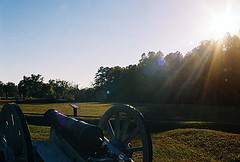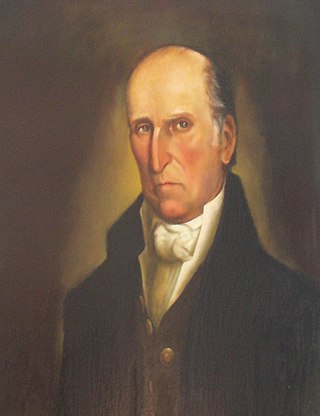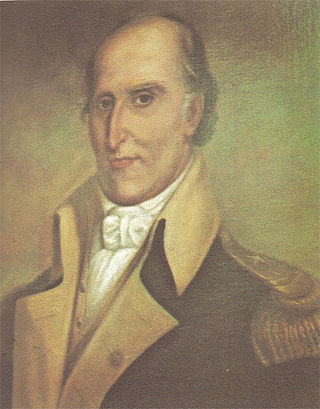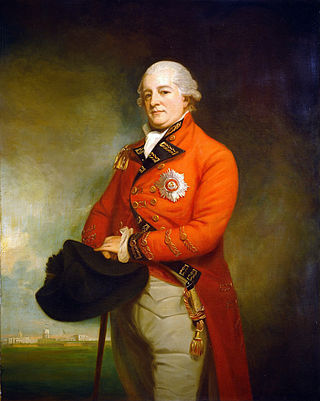
Gowensville is an unincorporated community in Greenville County, South Carolina, United States. [1] The community sits along the Cherokee Foothills Scenic Highway and South Carolina Highway 14, flanking the Spartanburg County border to its east.

Gowensville is an unincorporated community in Greenville County, South Carolina, United States. [1] The community sits along the Cherokee Foothills Scenic Highway and South Carolina Highway 14, flanking the Spartanburg County border to its east.
In 1780, during the American Revolutionary War, a skirmish between Loyalist and Patriot forces occurred at Gowen's Fort, named for soldier John "Buck" Gowen, the namesake of the town of Gowensville. [2] A band of Loyalists and Chickamauga Cherokee, commanded by Captain William Bates, approached the area in an attempt to siege the Patriot stronghold. Despite their strong resistance, Patriot forces succumbed to a lack of ammunition and were forced to surrender. Bates initially promised to protect those within the fort from the Indian fighters, but upon their exit, Bates gave the command for all of his soldiers to kill the resistance. The number of deceased is unknown. [3]
Gowensville is home to Campbell's Covered Bridge, the last covered bridge in the state of South Carolina. [4] The locale is considered part of the informal region known as the "Dark Corner", which represented a safe haven for political dissenters and moonshiners in South Carolina throughout the 1800s. [5]

Brigadier General Francis Marion, also known as the "Swamp Fox", was an American military officer, planter, and politician who served during the French and Indian War and the Revolutionary War. During the American Revolution, Marion supported the Patriot cause and enlisted in the Continental Army, fighting against British forces in the Southern theater of the American Revolutionary War from 1780 to 1781.

Ninety Six is a town in Greenwood County, South Carolina, United States. The population was 1,998 at the 2010 census.

Andrew Pickens was a militia leader in the American Revolution. A planter and slaveowner, he developed his Hopewell plantation on the east side of the Keowee River across from the Cherokee town of Isunigu (Seneca) in western South Carolina. He was elected as a member of the United States House of Representatives from western South Carolina. Several treaties with the Cherokee were negotiated and signed at his plantation of Hopewell.

John Sevier was an American soldier, frontiersman, and politician, and one of the founding fathers of the State of Tennessee. A member of the Democratic-Republican Party, he played a leading role in Tennessee's pre-statehood period, both militarily and politically, and he was elected the state's first governor in 1796. He served as a colonel of the Washington District Regiment in the Battle of Kings Mountain in 1780, and he commanded the frontier militia in dozens of battles against the Cherokee in the 1780s and 1790s.

The Battle of Kings Mountain was a military engagement between Patriot and Loyalist militias in South Carolina during the Southern Campaign of the American Revolutionary War, resulting in a decisive victory for the Patriots. The battle took place on October 7, 1780, 9 miles (14 km) south of the present-day town of Kings Mountain, North Carolina. In what is now rural Cherokee County, South Carolina, the Patriot militia defeated the Loyalist militia commanded by British Major Patrick Ferguson of the 71st Foot. The battle has been described as "the war's largest all-American fight".
South Carolina was outraged over British tax policies in the 1760s that violated what they saw as their constitutional right to "no taxation without representation". Merchants joined the boycott against buying British products. When the London government harshly punished Massachusetts for the Boston Tea Party, South Carolina's leaders joined eleven other colonies in forming the Continental Congress. When the British attacked Lexington and Concord in the spring of 1775 and were beaten back by the Massachusetts Patriots, South Carolina Patriots rallied to support the American Revolution. Loyalists and Patriots of the colony were split by nearly 50/50.

The Battle of Kettle Creek was the first major victory for Patriots in the back country of Georgia during the American Revolutionary War that took place on February 14, 1779. It was fought in Wilkes County about eleven miles (18 km) from present-day Washington, Georgia. A militia force of Patriots decisively defeated and scattered a Loyalist militia force that was on its way to British-controlled Augusta.

The Overmountain Men were American frontiersmen from west of the Blue Ridge Mountains which are the leading edge of the Appalachian Mountains, who took part in the American Revolutionary War. While they were present at multiple engagements in the war's southern campaign, they are best known for their role in the American victory at the Battle of Kings Mountain in 1780. The term "overmountain" arose because their settlements were west of, or "over", the Blue Ridge, which was the primary geographical boundary dividing several of the 13 American states from the Native American lands to the west. The Overmountain Men hailed from parts of Virginia, North Carolina, and what is now Tennessee and Kentucky.

The 84th Regiment of Foot (Royal Highland Emigrants) was a British regiment in the American Revolutionary War that was raised to defend present day Ontario, Quebec and Atlantic Canada from the constant land and sea attacks by American Revolutionaries. The 84th Regiment was also involved in offensive action in the Thirteen Colonies; including North Carolina, South Carolina, Georgia, Virginia and what is now Maine, as well as raids upon Lake Champlain and the Mohawk Valley. The regiment consisted of 2,000 men in twenty companies. The 84th Regiment was raised from Scottish soldiers who had served in the Seven Years' War and stayed in North America. As a result, the 84th Regiment had one of the oldest and most experienced officer corps of any regiment in North America. The Scottish Highland regiments were a key element of the British Army in the American Revolution. The 84th Regiment was clothed, armed and accoutred the same as the Black Watch, with Lieutenant Colonel Allan Maclean commanding the first battalion and Major General John Small of Strathardle commanding the second. The two Battalions operated independently of each other and saw little action together.

The southern theater of the American Revolutionary War was the central theater of military operations in the second half of the American Revolutionary War, 1778–1781. It encompassed engagements primarily in Virginia, Georgia, North Carolina, and South Carolina. Tactics consisted of both strategic battles and guerrilla warfare.

David Fanning was a Loyalist leader in the American Revolutionary War in North and South Carolina. Fanning participated in approximately 36 minor engagements and skirmishes, and in 1781, captured the Governor of North Carolina, Thomas Burke, from the temporary capital at Hillsborough. Additionally, Fanning was captured by Patriot forces 14 times throughout the war, each time escaping or receiving a pardon. After the British defeat in the war, Fanning fled to Canada, where he was elected to the Legislative Assembly of New Brunswick from 1791 to 1801 representing Kings County. After being convicted of rape in 1801, Fanning was expelled from New Brunswick, and settled in Nova Scotia, where he lived the remainder of his life.

Griffith Rutherford was an American military officer in the Revolutionary War and the Cherokee-American Wars, a political leader in North Carolina, and an important figure in the early history of the Southwest Territory and the state of Tennessee.
James Moore was a Continental Army general during the American Revolutionary War. Moore was born into a prominent political family in the colonial Province of North Carolina, he was one of only five generals from North Carolina to serve in the Continental Army. He spent much of his childhood and youth on his family's estates in the lower Cape Fear River area, but soon became active in the colonial military structure in North Carolina.

The Capture of Savannah, sometimes the First Battle of Savannah, or the Battle of Brewton Hill, was an American Revolutionary War battle fought on December 29, 1778 pitting local American Patriot militia and Continental Army units, holding the city, against a British invasion force, commanded by Lieutenant Colonel Archibald Campbell. The British capture of the city led to an extended occupation and was the opening move in the British southern strategy to regain control of the rebellious Southern provinces by appealing to the relatively strong Loyalist sentiment there.
Brigadier-General Andrew Williamson was a Scottish-born trader, planter, and military officer. Serving in the South Carolina Militia, rising to be commissioned as brigadier general in the Continental Army in the American War of Independence. He led numerous campaigns against Loyalists and Cherokee, who in 1776 had launched an attack against frontier settlements across a front from Tennessee to central South Carolina. Williamson was particularly effective in suppressing the Cherokee, killing an unknown number of Cherokees and destroying 31 of their towns. As a result of his Indian campaign, the Cherokee ceded more than a million acres in the Carolinas.

The Snow Campaign was one of the first major military operations of the American Revolutionary War in the southern colonies. An army of up to 3,000 Patriot militia under Colonel Richard Richardson marched against Loyalist recruiting centers in South Carolina, flushing them out and frustrating attempts by the Loyalists to organize. The Patriot expedition became known as the Snow Campaign due to heavy snowfall in the later stages of the campaign.
The Battle of Lindley's Fort was part of a campaign by Loyalist and Cherokee forces to gain control over the South Carolina backcountry from Patriot forces early in the American Revolutionary War. The Cherokees were involved because ongoing encroachment of their territory in the area had led them to take up arms. These activities prompted settlers to seek refuge at Lindley's Fort in present-day Laurens County. A joint force of Cherokee and Loyalists adorned with Indian warpaint descended on the fort one day after about 150 militiamen arrived at the stockade fort. The defenders repulsed the attackers, and when they withdrew, made a sortie and pursued them. Two Loyalists were killed and 13 taken prisoner.

The siege of Savage's Old Fields was an encounter between Patriot and Loyalist forces in the back country town of Ninety Six, South Carolina, early in the American Revolutionary War. It was the first major conflict in South Carolina in the war, having been preceded by bloodless seizures of several military fortifications in the province.

Colonists who supported the British cause in the American Revolution were Loyalists, often called Tories, or, occasionally, Royalists or King's Men. George Washington's winning side in the war called themselves "Patriots", and in this article Americans on the revolutionary side are called Patriots. For a detailed analysis of the psychology and social origins of the Loyalists, see Loyalist.

The Battle of Great Cane Brake was a skirmish fought on December 22, 1775, during the American Revolutionary War in what was then Ninety-Six District, South Carolina, modern Greenville County.